Mil Mi-4
| Mi-4 | |
|---|---|
 | |
| Mil Mi-4 at Prague Aviation Museum | |
| Role | Transport helicopter |
| Manufacturer | Mil Moscow Helicopter Plant |
| First flight | 3 June 1952 |
| Introduction | 1953 |
| Status | Limited Service; North Korean Air Force |
| Primary users | Soviet Air Force Polish Air Force |
| Produced | 1951–1979 |
| Number built | over 4,000 including Z-5s |
| Variants | Harbin Z-5 |
The Mil Mi-4 (USAF/DoD reporting name "Type 36",[1] NATO reporting name "Hound").[2] was a Soviet transport helicopter that served in both military and civilian roles.
Design and development
The Mi-4 was designed in response to the American H-19 Chickasaw and the deployment of U.S. helicopters during the Korean War. While the Mi-4 superficially resembles the H-19 Chickasaw, it is a larger helicopter and is able to lift more weight. The first model entered service in 1952, and replaced the Mi-1. The helicopter was first displayed to the outside world in 1952 at the Soviet Aviation Day in Tushino.
One Mi-4 was built with a jettisonable rotor. It served as an experimental vehicle for future pilot's means of safety and ejection designs.[3]
Operational history
The Mi-4 transport helicopter laid the beginning of the Soviet Army Aviation, it was widely used both in the armed forces and in the national economy and for several decades remained the main type of helicopter in the inventory of the Soviet Armed Forces and of the Civil Air Fleet. The Mi-4 went out of service with the development of the Mi-8. It is not used by the Russian Air Force anymore, though it remained in service in some countries as a utility helicopter or as a military transport a while longer. Albania was thought to be the final country using the helicopter and by 2005 all were out of service. The Mi-4 played a very important role in Bangladesh liberation war of 1971. The Mi-4 was the workhorse of the Indian Army at the time. A highly successful heli-borne operation, the Meghna Heli Bridge, using Mi-4s helped the Indian Army's 57 Mountain Division clear the Meghna River. The helilift of a battalion of Indian troops to the outskirts of Sylhet was the first heli-borne operation of the Indian army.
Much like the UH-1 Huey, after it was gradually phased out of military service, it was used in various domestic roles: search and rescue, firefighting, polar expeditioning, construction site cargo helicopter, commercial flights and many others.[3]
An official video of a North Korean Air Force combat flying skills competition released in 2014 shows that the Mi-4 is still in limited service in North Korea.[4]
Variants
- V-12
- Prototype. Designation reused for the Mi-12.
- Mi-4 (NATO – Hound-A)
- Basic production version.
- Mi-4A
- Assault transport helicopter.
- Mi-4AV
- Armed versions based on the Mi-4A.
- Mi-4GF
- Factory designation for demilitarised Mi-4 for use in the Civil Air Fleet.
- Mi-4L Lyukes
- Six-seat VIP transport version, sometimes converted into an air ambulance helicopter.
- Mi-4VL
- Fire-fighting version of Mi-4L.
- Mi-4M (NATO – Hound-C)
- Armed close-support helicopter, fitted with a gun turret. Designation alternatively applied to the Mi-4VM, and also reused for ambulance variant for the Soviet Ministry of Health. Export designation Mi-4ME.
- Mi-4MR
- Upgraded version of Mi-4VM.
- Mi-4P / Mi-4VP
- Civil transport helicopter, with accommodation for between 8 and 11 passengers, plus eight stretchers and a medical attendant for air ambulance duties.
- Mi-4PL (NATO – Hound-B)
- Anti-submarine warfare helicopter.
- Mi-4PS
- SAR version.
- Mi-4S Salon
- VIP transport helicopter.
- Mi-4Skh
- Multi-role agricultural helicopter, with a large chemical container in the main cabin. Also used as a fire-fighting helicopter.
- Mi-4T
- Major military production version, equipped with a large diameter main rotor and bulged windows.
- Mi-4VM (VM-12)
- Anti-submarine warfare helicopter.
- Mi-4BT
- Minesweeper with floats.
- Mi-4RI
- Mi-4M equipped with the Rion experimental sonar.
- Mi-4MT
- Torpedo-carrying ASW attack (killer) aircraft derived from Mi-4M.
- Mi-4MU
- Attack helicopter.
- Mi-4MO
- Search helicopter with Oka sonar.
- Mi-4MS
- Search helicopter with Soora infra-red sensor.
- Mi-4FV (Mi-4KV)
- Photographic and guidance helicopter.
- Mi-4Schch
- "Polar version" of Mi-4FV for working at the Soviet Arctic and Antarctic research stations.
- Mi-4SP
- Special rescue modification.
- Mi-4PG
- Experimental version equipped with an external load sling system.
- Mi-4SV
- Mi-4 with improved heat insulation for working in the Far North.
- Mi-4N "Filin" (Horned owl)
- Experimental reconnaissance version intended for night-time use.
- Mi-4KK (Mi-4VKP)
- Mobile command post.
- Mi-4KU (Mi-4VPU)
- Mobile command post for controlling Air Force units.
- Mi-4U
- Target-designator version carrying the Oospekh (Success) system.
- Mi-4GR
- Mi-4 fitted with Grebeshok-3 (Haircomb-3) wide-range panoramic detection and relay radar.
- Mi-4TARK
- TV-equipped artillery reconnaissance and spotting helicopter.
- Mi-4MK (Mi-4PP)
- ECM version.
- Mi-4UM
- Radio-controlled target drone version.
- Harbin Z-5
- Chinese military transport helicopter. Chinese production version.
- Harbin Z-6
- Prototype turbine powered version of the Z-5, no production undertaken.
- Xuanfeng
- Chinese civil transport helicopter. Chinese production version.
- Unnamed Variants
- Mi-4 minelayer version produced by converting troop-carrier helicopters.
- Mi-4 modified for transporting and laying gas pipelines.
- Mi-4 with Panorama 360 cin camera system produced by conversion.
- Mi-4 with the Pristavka (Add-on) radio equipment developed in 1957 for guidance of remote-controlled reconnaissance balloons.
- Mi-4s used as testbeds. Apart from the above-mentioned versions, the Mi-4 and Mi-4A were widely used as testbeds of various kinds for testing subassemblies and systems of future aircraft, as well as equipment for other branches of industry.
Operators
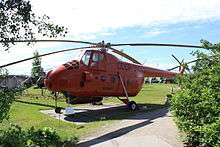
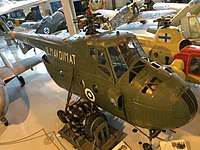
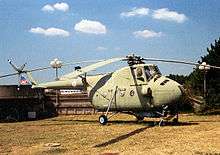
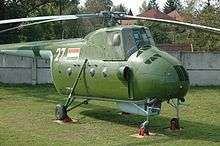
- North Yemen Air Force [18]
Specifications (Mi-4A)
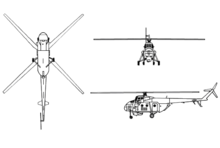
Data from www.globalsecurity.org/military/world/russia/mi-4-specs.htm
General characteristics
- Crew: One or two pilots
- Capacity: 16 troops or up to 1,600 kg (3,520 lb) of cargo
- Length: 16.80 m (55 ft 1.4 in)
- Rotor diameter: 21.00 m (68 ft 11 in)
- Height: 4.40 m (14 ft 5 in)
- Disc area: 346.4 m² (3,727 ft²)
- Empty weight: 5,100 kg (11,220 lb)
- Loaded weight: 7,150 kg (15,730 lb)
- Max. takeoff weight: 7,550 kg (16,610 lb)
- Powerplant: 1 × Shvetsov ASh-82V radial engine, 1,250 kW (1,675 hp)
Performance
- Maximum speed: 185 km/h (116 mph)
- Range: 500 km (313 mi)
- Service ceiling: 5,500 m (18,040 ft)
- Rate of climb: m/s (ft/min)
- Disc loading: 41 kg/m² (8 lb/ft²)
- Power/mass: 0.21 kW/kg (0.13 hp/lb)
See also
- Related development
- Aircraft of comparable role, configuration and era
Notes
- ↑ "Designations of Soviet and Russian Military Aircraft and Missiles". Designation-systems.net. 2008-01-18. Retrieved 2012-10-28.
- ↑ "Designations of Soviet and Russian Military Aircraft and Missiles". Designation-systems.net. 2008-01-18. Retrieved 2012-10-28.
- 1 2 John Pike. "Mi-4 HOUND (MIL)". Globalsecurity.org. Retrieved 2012-10-28.
- ↑ https://www.youtube.com/watch?v=p0yNcM4kV6g
- 1 2 3 4 "Military Helicopter Market 1971 pg. 575". Retrieved 2013-04-03.
- ↑ "Military Helicopter Market 1981 pg. 321". flightglobal.com. Retrieved 3 April 2013.
- ↑ "Military Helicopter Market 1975 pg. 293". flightglobal.com. Retrieved 3 April 2013.
- 1 2 3 4 5 "Military Helicopter Market 1971 pg. 576". Retrieved 2013-04-03.
- 1 2 3 "Military Helicopter Market 1971 pg. 577". Retrieved 2013-04-03.
- 1 2 3 4 "Military Helicopter Market 1971 pg. 578". Retrieved 2013-04-03.
- ↑ "Military Helicopter Market 1975 Force Aerienne du Mali". flightglobal.com. Retrieved 3 April 2013.
- ↑ "Military Helicopter Market 1971 pg. 579". flightglobal.com. Retrieved 3 April 2013.
- 1 2 "Military Helicopter Market 1975 pg. 304". Retrieved 2013-04-03.
- 1 2 3 4 5 "Military Helicopter Market 1971 pg. 580". Retrieved 2013-04-03.
- ↑ "Military Helicopter Market 1981 pg. 372". flightglobal.com. Retrieved 3 April 2013.
- ↑ "Military Helicopter Market 1972 pg. 202". flightglobal.com. Retrieved 3 April 2013.
- ↑ "Military Helicopter Market 1981 pg. 374". flightglobal.com. Retrieved 3 April 2013.
- 1 2 3 "Military Helicopter Market 1971 pg. 581". Retrieved 2013-04-03.
References
- Bill Gunston, An Illustrated Guide to Military Helicopters, Salamander Books Ltd, London 1981. ISBN 978-0861011100
- Bob Ogden, Aviation Museums and Collections of The Rest of the World, UK: Air-Britain 2008. ISBN 978-0-85130-394-9
External links
| Wikimedia Commons has media related to Mil Mi-4. |
The initial version of this article was based on material from aviation.ru. It has been released under the GFDL by the copyright holder.